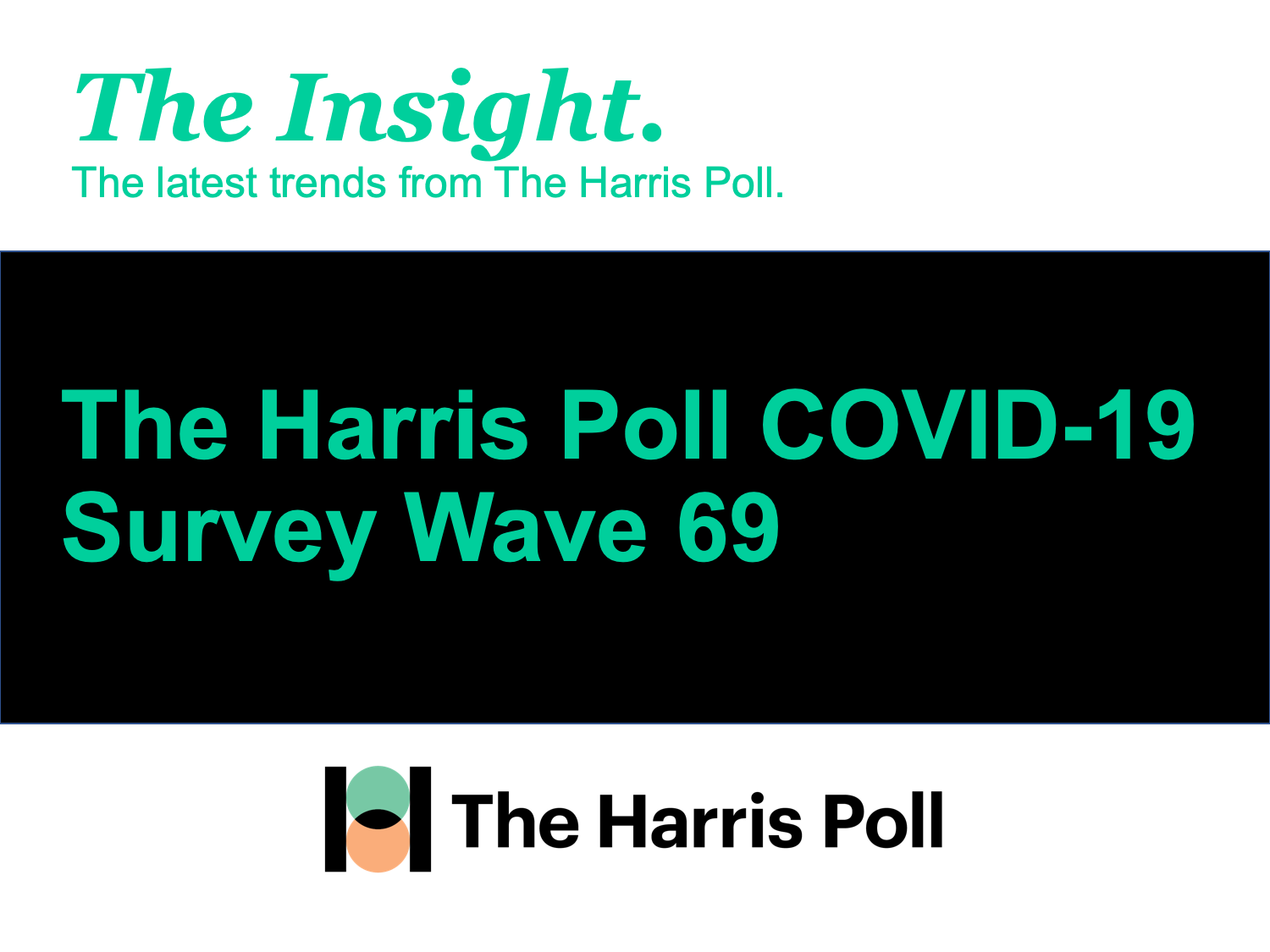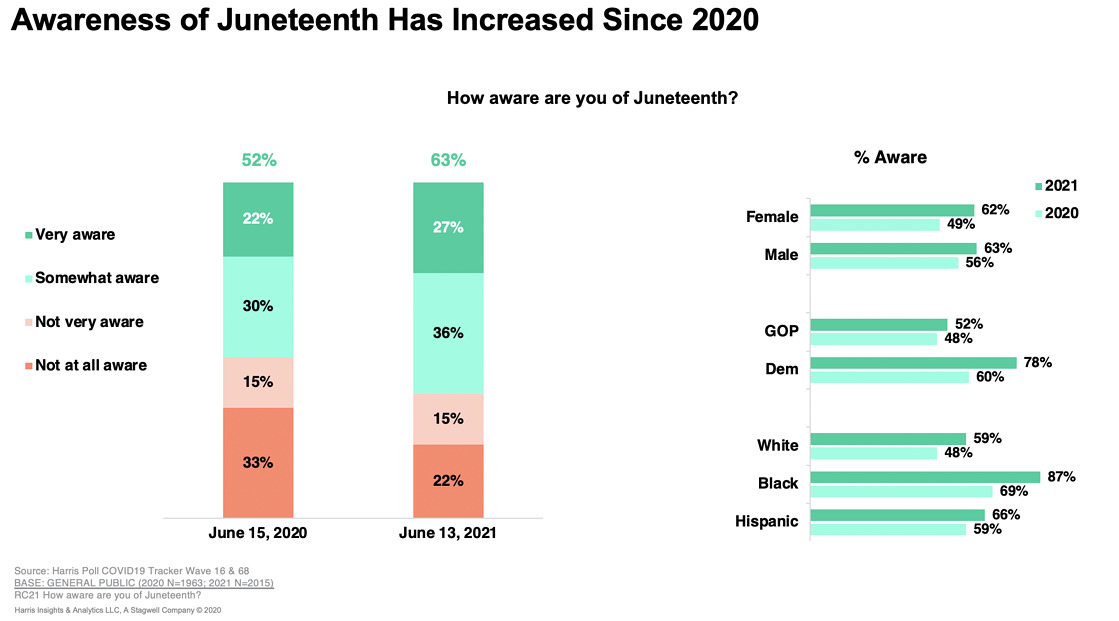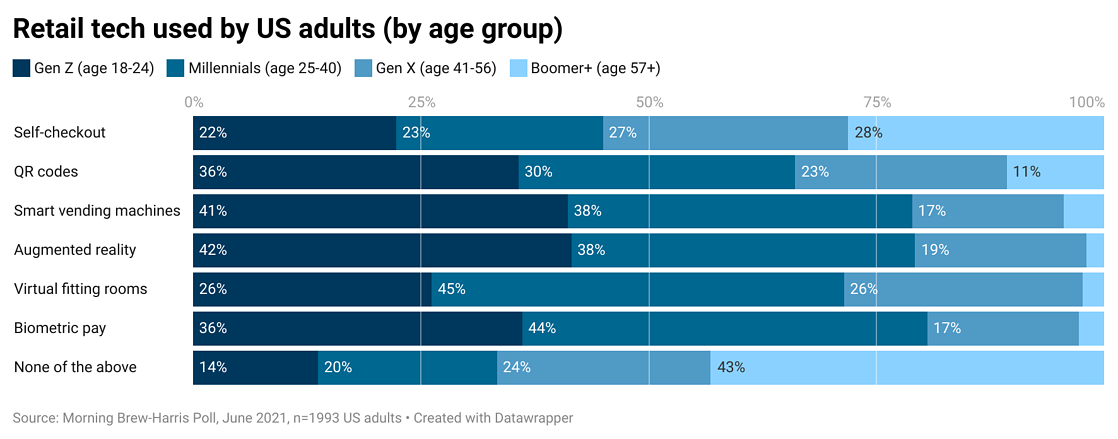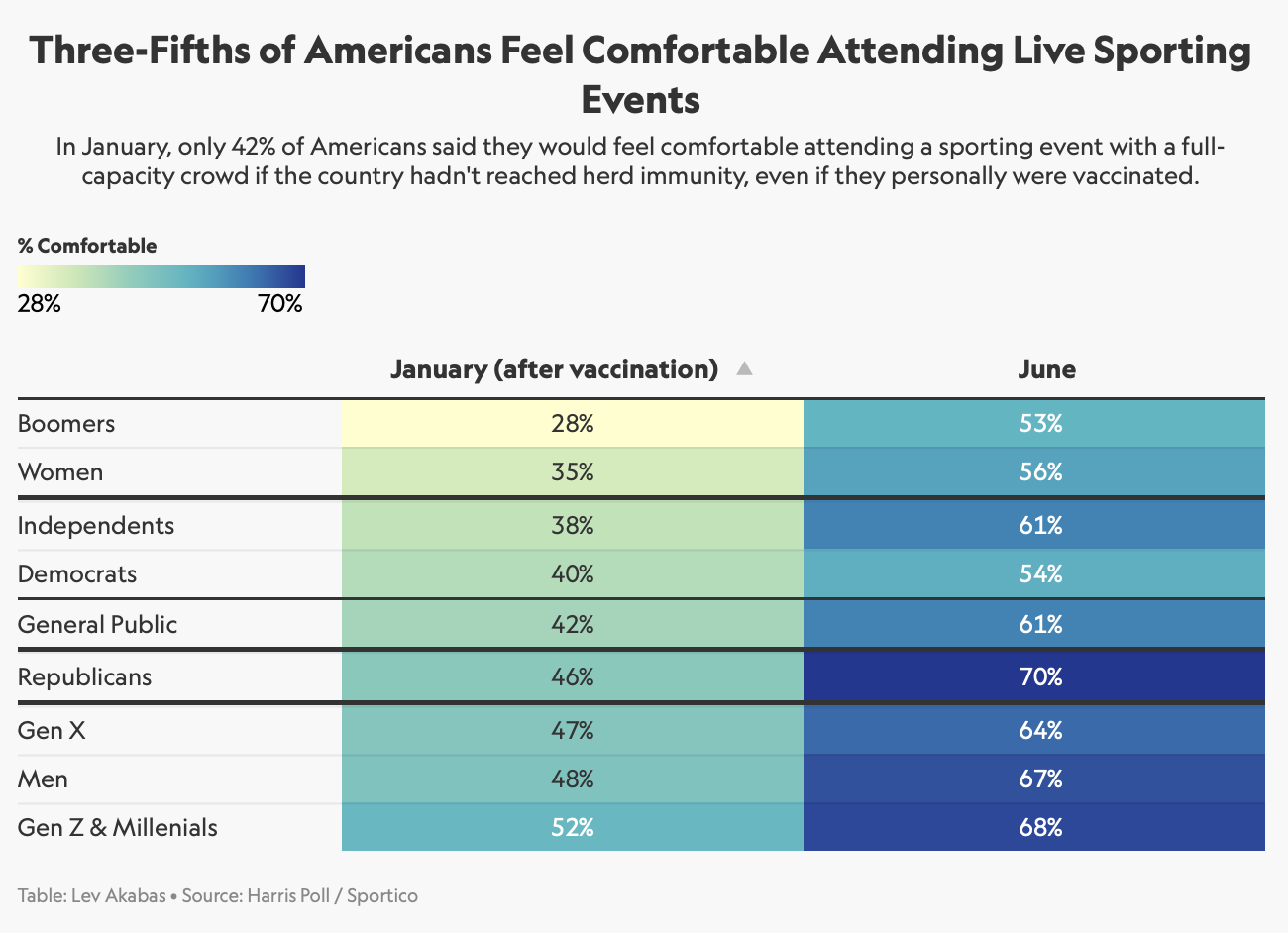Brief • 4 min Read

In The Harris Poll Tracker (Week 69) fielded June 18th to 20th, 2021 among 2,038 U.S. adults, we look at the the impact of Juneteenth, the role of technology while shopping, sentiment towards the newly FDA approved Alzheimer’s drug, an update on returning to major league sporting events, and raising menu prices to support higher wages for workers
As a public service, our team has curated key insights to help leaders navigate COVID-19. Full survey results, tables, and weekly summaries can be accessed for free at The Harris Poll COVID-19 Portal. We will continue to actively field on a regular cadence to track the shifts in sentiment and behaviors as the news and guidelines evolve.
A New Federal Holiday: Juneteenth
Last week, the U.S. government made June 19th (Juneteenth) a federal holiday in honor of the day that the last enslaved people in the U.S. found out they were free. We asked Americans about Juneteenth last year and checked back in to see how views shifted.
- Awareness is on the rise: Slightly more than half (52%) of Americans were at least somewhat aware of Juneteenth in 2020. That number has risen to (63%) in 2021.
- Overall, support for making Juneteenth paid day off is high but unchanged: Two-thirds (66%) agreed a year ago that companies should honor the day with a work holiday compared to slightly more (68%) this year.
- Room for education: Among those aware of Juneteenth, only three in five (59%) could correctly identify its origin.
- Commemorations around the country: Celebrations of Juneteenth over the weekend ranged from full blown festivals to unveilings of statues in honor of George Floyd. See how Americans celebrated in other cities.

Takeaway: Companies have an opportunity as only one in five (20%) of employed Americans said that their company made an effort to connect Juneteenth to diversity, equity, and inclusion initiatives.
Americans Don’t Want More Tech in Their Shopping Experience: Morning Brew-Harris Poll
From pay-by-palm to virtual fitting rooms, retailers are investing money in innovations that streamline the shopping experience. But are consumers even using the shiny new tech? We take a closer look in our latest survey in partnership with Morning Brew.
- Self-checkout is conventional: that’s why 7 in 10 (71%) Americans said they have used it while shopping, but only a quarter (26%) said they’ve shopped somewhere with fully automated checkout – like an Amazon Go store.
- Other futuristic tech for shopping: One quarter (25%) said they have used QR codes while shopping, while (19%) have used smart vending machines, (10%) used virtual fitting rooms, and only (8%) have used biometric pay.
- Keep it simple: (30%) of respondents said they want more technology integrated in their shopping experience, while (57%) either want less or for it to stay the same.

Takeaway: Retailers are rushing to innovate, but consumers are slow to adopt new habits. Even a pandemic-driven novelty like curbside pickup isn’t as popular: Only (18%) of say they’ve used it.
Most Americans Believe New Alzheimer’s Drug Is Effective, but Many Are Concerned With FDA Process: STAT-Harris Poll
Earlier in June, the Food and Drug Administration approved a drug to treat patients with Alzheimer’s. It is the first new drug approved by the FDA for the disease since 2003. We partnered with STAT to gauge Americans’ feelings towards the newest treatment on the market:
- A majority (61%) of Americans are at least somewhat concerned about Alzheimer’s as a public health threat, a steady number across all demographics.
- Even more, (66%) are aware of the recent FDA approval of the new drug, with a quarter (25%) of Boomers and Millennials saying they are very aware compared to just (14%) of Gen Zers.
- Three-fifths (60%) of those who are familiar with the details of the new treatment believe the medication will be effective, but (56%) also say they have concerns about the regulatory process used to endorse the drug.
- Regardless, the vast majority (78%) said they are excited by the prospect of a new treatment for the disease.
Takeaway: Although there is excitement, the price tag of $56,000 is cause for concern since that is far above the $8,300 threshold that a nonprofit determined would be considered cost-effective.
Sellouts Aside, 40% Of Americans Still Wary of Live Sporting Events: Sportico-Harris Poll
More than half of the U.S. population has received at least one dose of a COVID-19 vaccine and NBA playoff games are selling out, but our latest poll in partnership with Sportico shows that fan attitudes are not rebounding as expected.
- Americans previously overestimated their hesitancy to return to live sporting events: Only (61%) say they would be comfortable attending a game at full capacity with a mix of vaccinated and unvaccinated fans. Although this number is much higher than five months ago, the data show a greater hesitancy than anticipated.
- Outdoor events are still viewed as notably safer than indoor ones, with just over half (52%) saying they would be comfortable attending a full-capacity event of mixed vaccination status in an indoor arena.
- Vaccinated-only seating sections: (83%) of vaccinated Americans say they would feel safer at a full-capacity venue sitting in a section designated for only vaccinated fans.
- Some Americans still say that a number of innovations to venue sanitation are “critical” to their feeling safe enough to return to stadiums: (49%) of fans think that the availability of PPE, such as hand sanitizer and hygiene packages, are essential to the return to stands.

Takeaway: While there is still hesitancy among the general population to throw themselves into crowded venues, people continue to feel more comfortable with returning to stadiums and major league sports teams are listening.
How Much Should a Burrito Cost?
Earlier this month, Chipotle announced they raised menu prices by about 4% to offset the cost of increasing their workers’ wages from $11 to $18 an hour. The move was met with praise by some and scoffing by others, so we checked in with Americans to see how they felt about paying more for a burrito:
- Nearly three-fifths (57%) of Americans support restaurants raising menu prices in order to pay employees a higher wage.
- Among those who support raising menu prices, two-thirds (66%) are willing to pay 3% or more of their total bill and nearly one-third (31%) are willing to pay 5% or more, including (40%) of Boomers – but only (9%) of Gen Z.
- Most customers will stay, though some will cut back: (54%) of consumers say if their favorite restaurant raised menu prices to pay higher wages they would not change how often they eat there. Over one-third (37%) say they would cut back, including half (49%) of Republicans (vs 29% of Democrats).
- Three-quarters of consumers (74%) expect other restaurants to follow Chipotle’s lead by raising menu prices to pay workers a higher wage, though expectations are soft: (53%) say others will probably follow and (20%) say they definitely will.
Takeaway: Chipotle’s motto is “food with integrity” – and one way for companies to exemplify such integrity and values is to invest in their employees’ well-being.
Subscribe for more Insights
Subscribe to our newsletter for the latest trends in business, politics, culture, and more.
Download the Data
This survey was conducted online within the U.S. by The Harris Poll from June 18 to 20, among a nationally representative sample of 2,038 U.S. adults.
Download
Subscribe for more Insights
Subscribe to our newsletter for the latest trends in business, politics, culture, and more.
Download the Data
This survey was conducted online within the U.S. by The Harris Poll from June 18 to 20, among a nationally representative sample of 2,038 U.S. adults.
DownloadRelated Content








